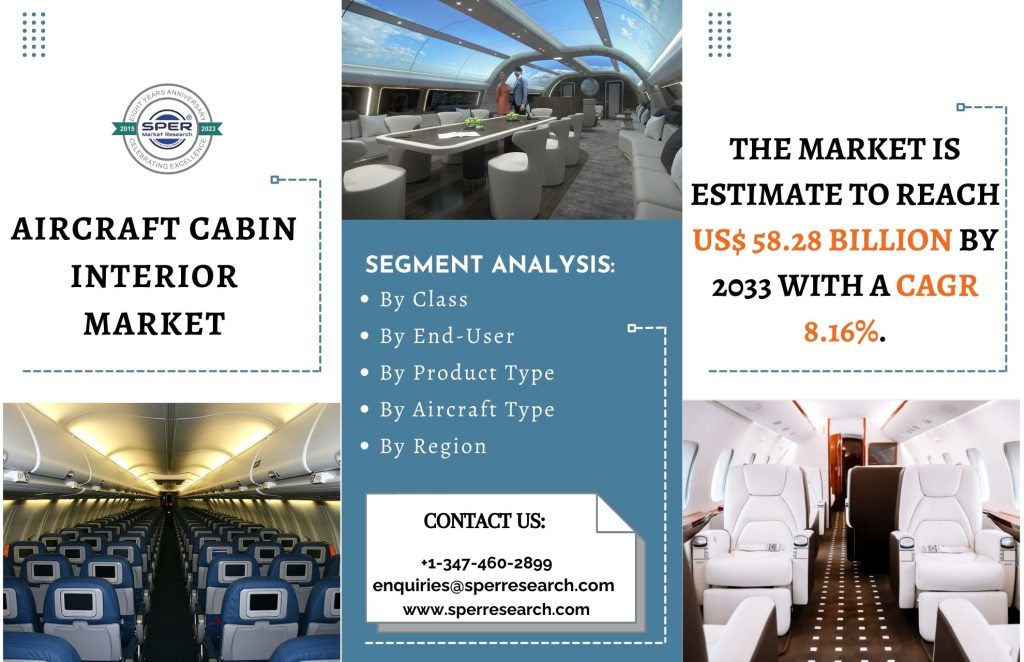Aircraft Cabin Interior Market Share 2023- Industry Trends, Revenue, Growth Drivers, Business Challenges and Future Investment Opportunities Till 2033: SPER Market Research

The interior of an aircraft is its most important component since it gives occupants a cozy, secure, and visually beautiful place to live while in the air. Every now and then, a lot of people may feel uncomfortable due to the high altitude, which will make their trip less enjoyable. Airlines upgrade their interior amenities to improve the comfort and quality of travel for their customers. An airplane’s interior is made up of various elements such as the bathroom, windows, internal aircraft panels, storage bins, in-flight entertainment and communication systems, and cabin seats.
According to SPER market research, ‘Aircraft Cabin Interior Market Size- By Class, By Type, By End-User, By Product Type, By Aircraft Type – Regional Outlook, Competitive Strategies and Segment Forecast to 2033’ state that the Aircraft Cabin Interior Market is predicted to reach USD 58.28 Billion by 2033 with a CAGR of 8.16%.
Driver:
A discernible increase in demand for comfortable travel accommodations has occurred in the past few years. Airlines have incorporated features like in-flight entertainment and communication systems that are integrated with seats and coaches, as well as privacy-enhancing features like cabin dividers and comfortable convertible beds for longer flights, into their interior design. Protective headrests and other seat adjustments are among the new features that manufacturers of aircraft interiors are incorporating to enhance passenger comfort while flying. The primary drivers of the market’s expansion include consumer preferences shifting in favor of more comfortable travel, the expanding safety requirement for 16-gauge seats, the spread of in-flight entertainment systems, and the creation of the Urban Air Mobility (UAM) platform.
Challenges:
The complex interaction of technological, regulatory, and economic factors presents a number of challenges for the aircraft cabin interior market. One of the biggest problems is the ongoing pressure to improve the traveler experience while meeting strict safety and legal requirements. Airlines are finding that using cutting-edge materials and technologies is essential to setting themselves apart through creative cabin designs. The requirement for stringent certification procedures, which hinder and complicate product development, frequently thwarts this goal. Airlines face difficulties when deciding whether to upgrade the interior of their cabins because the aviation industry is vulnerable to changes in fuel prices and economic downturns.
Request For Free Sample Report @ https://www.sperresearch.com/report-store/aircraft-cabin-interior-market.aspx?sample=1
Impact of COVID-19 on Global Aircraft Cabin Interior Market
The global market for aircraft interiors has not grown as much as it could due to the severe effects of the COVID-19 pandemic on the aerospace sector. Lockdown measures to stem the virus’s spread caused severe disruptions to global supply chains and suspended aerospace operations, which in turn caused a sharp decline in demand for aerospace components. The manufacturers found it very challenging to keep up with demand, but eventually aircraft orders began to rise.
Aircraft Cabin Interior Market Key Players:
Furthermore, the increased production of sophisticated aircraft with better-quality and more comfortable seats has led to a huge increase in the popularity of aircraft interiors in North America. Furthermore, the market for aircraft cabin interiors in North America has expanded due to a multitude of other factors, including the increase in aircraft demand and the introduction of lightweight interior components. Additionally, some of the market key players are Astronics Corporation, Cobham PLC, Collins Aerospace, Gogo, Inc, Honeywell International Inc., Hong Kong Aircraft Engineering Company Limited.
Aircraft Cabin Interior Market Segmentation:
The SPER Market Research report seeks to give market dynamics, demand, and supply forecasts for the years up to 2033. This report contains statistics on product type segment growth estimates and forecasts.
By Class: Based on the Class, Global Aircraft Cabin Interior Market is segmented as; First Class, Business Class, Premium Economy Class, Economy Class.
By End-User: Based on the End-User, Global Aircraft Cabin Interior Market is segmented as; OEM, Retrofit.
By Product Type: Based on the Product Type, Global Aircraft Cabin Interior Market is segmented as; Seat, Cabin Lighting, In-flight Entertainment and Connectivity, Aircraft Galley and Lavatory, Aircraft Windows and Windshields, Others.
By Aircraft Type: Based on the Aircraft Type, Global Aircraft Cabin Interior Market is segmented as; Narrow Body Aircraft, Wide Body Aircraft, Business Jets.
By Region: This report also provides the data for key regional segments of North America, Asia-Pacific, Latin America, Middle East & Africa and Europe.
This study also encompasses various drivers and restraining factors of this market for the forecast period. Various growth opportunities are also discussed in the report.
For More Information, refer to below link:-
Aircraft Cabin Interior Market Revenue
Related Reports:
Follow Us –
LinkedIn | Instagram | Facebook | Twitter
Contact Us:
Sara Lopes, Business Consultant – U.S.A.
SPER Market Research
+1-347-460-2899





